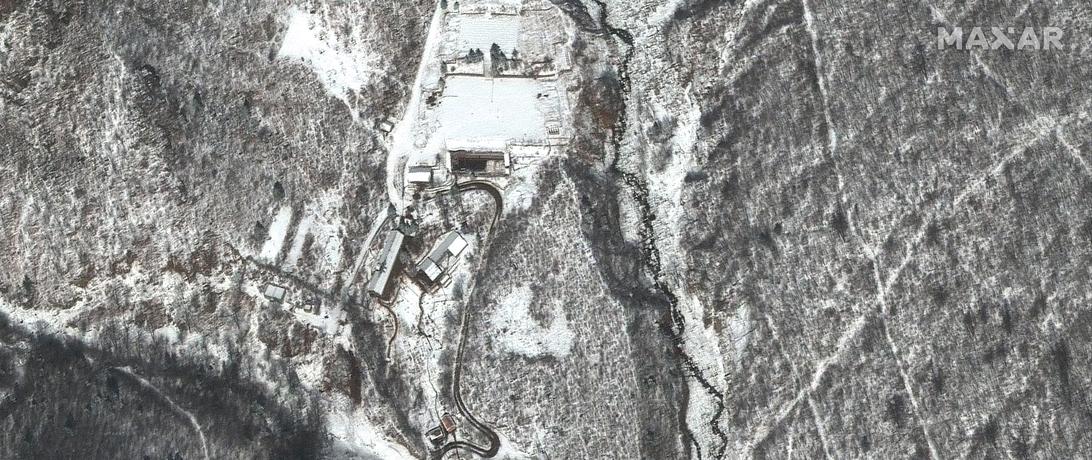
Summary of New Developments
In our previous publication dated 28 March 2022, we reported on developments observed at the DPRK's Punggye-ri nuclear test site, indicating that the DPRK had begun to reactivate some parts of the site.
Since then, available satellite images have shown ongoing developments at the site, including clear indications of a newly uncovered entrance to Tunnel 3 entrance and new spoil piles, and continuous signs of vehicle traffic. Altogether, these observations indicate that the DPRK has advanced work to restore this tunnel for use in a potential next nuclear weapon test.
Observations
On 28 March 2022, ONN reported signs of increasing activities within the Punggye-ri nuclear test site of the Democratic People's Republic of Korea (DPRK), especially at Tunnel 3 (also known as the South Portal). [1] Since then, available satellite images have shown continuing developments at this location, including clear indications of a newly uncovered tunnel entrance and new spoil piles, and further signs of vehicle traffic. These signs indicate that the excavation of Tunnel 3 has been steadily proceeding.
In May 2018, the test tunnels at the Punggye-ri nuclear test site were reportedly demolished. International media video footage taken during the demolition showed that the primary entrance to Tunnel 3 had been blown up by controlled explosions. [2] Thus far, however, no evidence has been found to indicate that the secondary entrance to this tunnel was also damaged by these explosions. [3] In March and April 2022, the DPRK's excavation and construction activities concentrated on areas near or at the secondary entrance to Tunnel 3, which suggests that the tunnel structure inside the secondary entrance might not have been damaged as severely as that of the primary entrance.
A satellite image from 24 March 2022 shows a square formation visible near the secondary entrance, which is likely related to the excavation of the edge of the mountain at this location (Figure 1). This square formation might be piles of logs for use in restoring the tunnel structure, given that the brown color of this square formation resembles the color of possible log piles nearby.
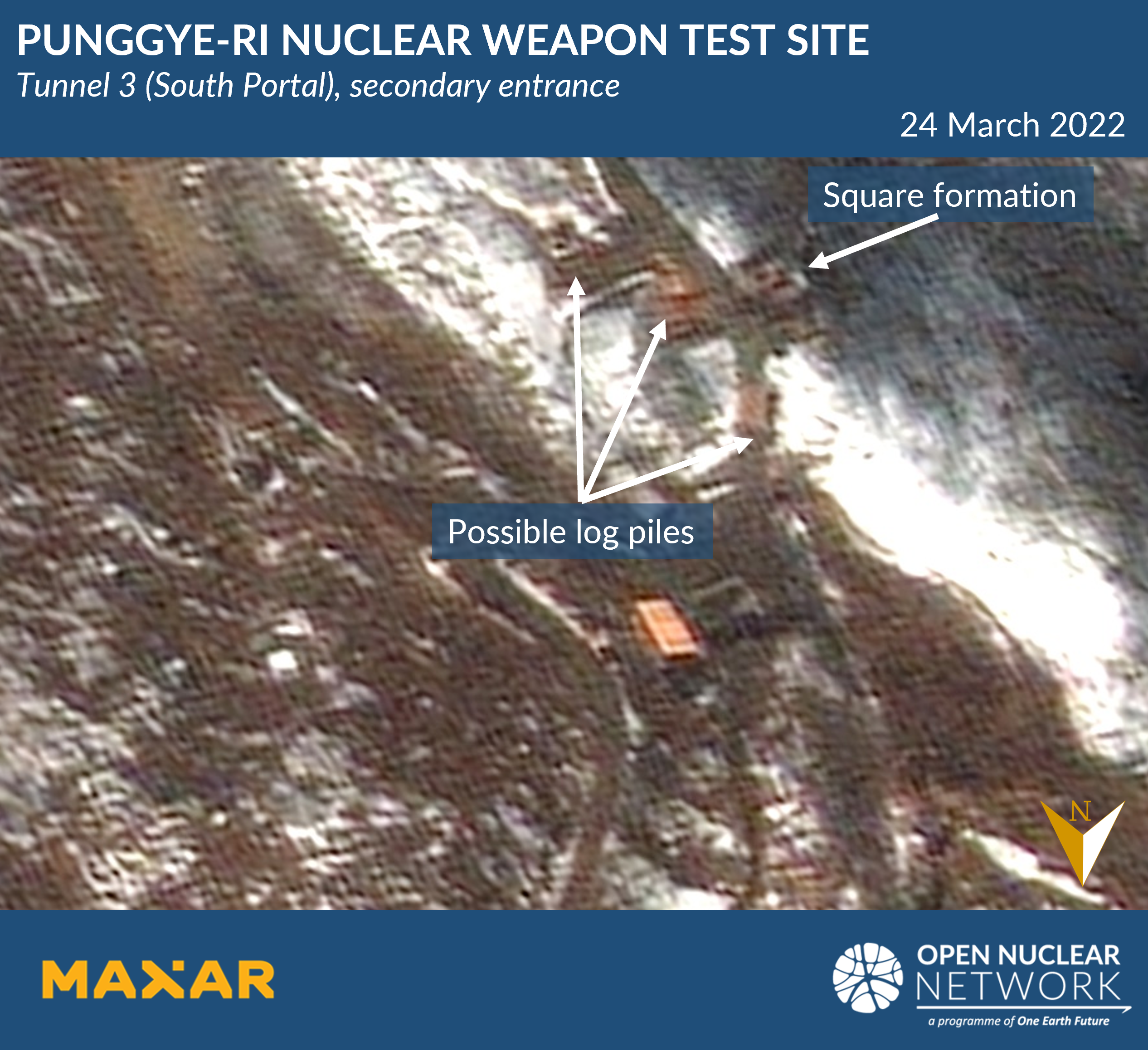
Image: © 2022 Maxar Technologies. All Rights Reserved. Reprinted by permission.
In another satellite image from 28 March 2022, this square formation is no longer visible (Figure 2). Instead, what appears to be a tunnel entrance became newly visible at a location nearby (Figure 2), approximately at the same point as the known former second entrance to Tunnel 3. If the square formation represented piles of logs, these logs could have been transported into this tunnel and used to support its interior structure during excavation.
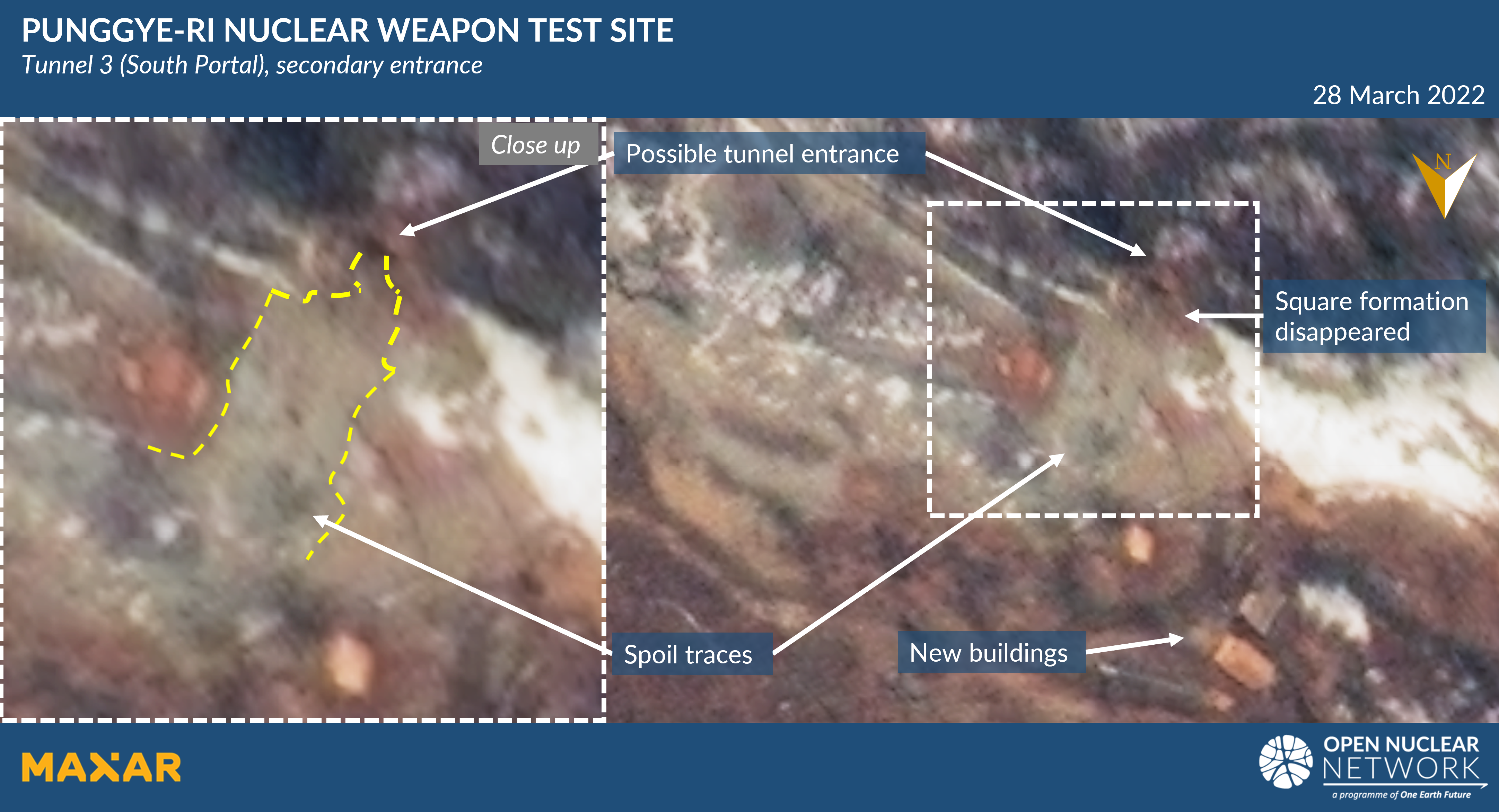
Image: © 2022 Maxar Technologies. All Rights Reserved. Reprinted by permission.
Traces of spoils stretched from this possible tunnel entrance across the road toward an old spoil pile nearby where a large amount of spoil piles from previous excavations of Tunnel 3 had accumulated (Figure 2). These signs suggest frequent transportation of spoils from the possible tunnel entrance to the old spoil pile nearby.
Based on these observations, it is assessed that, by 28 March, the DPRK likely established a preliminary entrance to Tunnel 3 and started excavation of the tunnel structure.
In the satellite image from 31 March 2022, the tunnel entrance became more clearly visible than in previous satellite images (Figure 3). In addition, what appears to be a new spoil pile became visible at a location across the road from this tunnel entrance (Figure 3). A transportation path for the new spoil pile is also visible. The new spoils were likely excavated and transported from this tunnel to this new spoil pile. [4] These signs indicate that, by 31 March, the tunnel entrance was likely completed and the excavation of Tunnel 3 further advanced.
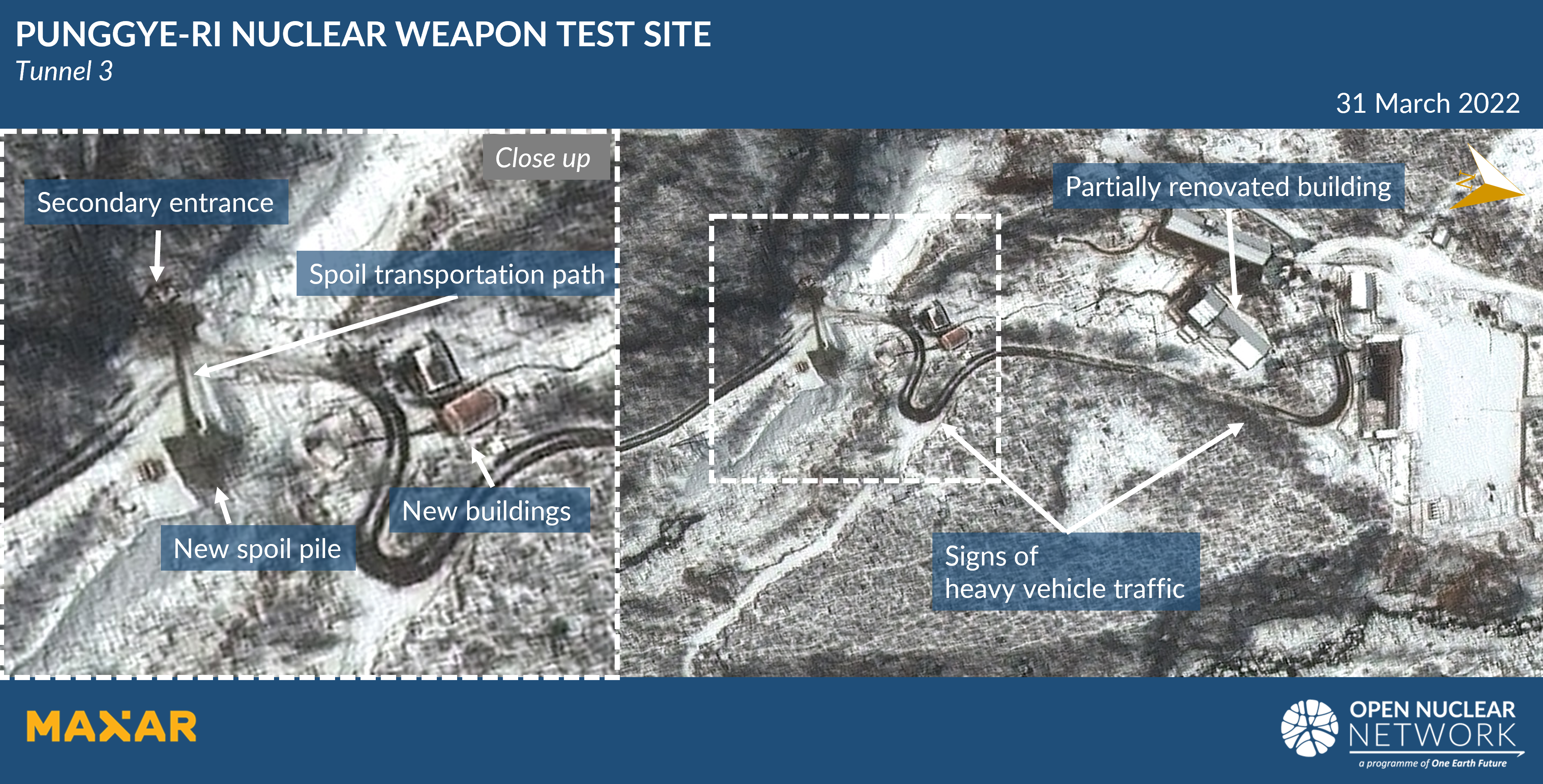
Image: © 2022 Maxar Technologies. All Rights Reserved. Reprinted by permission.
Another satellite image from 3 April 2022 shows that snow was cleared in the area surrounding the tunnel entrance and also shows surface leveling near the spoil pile and on the road leading to this tunnel entrance (Figure 4). These signs suggest continuous transportation of spoils from this tunnel to the spoil pile (Figure 4).
Additionally, on the same satellite image, a newly visible structure, possibly a small building, is present nearby, which is likely related to the excavation activities because of its proximity to the flattened ground surfaces (Figure 4).
These signs suggest steady ongoing progress of the excavation of Tunnel 3.
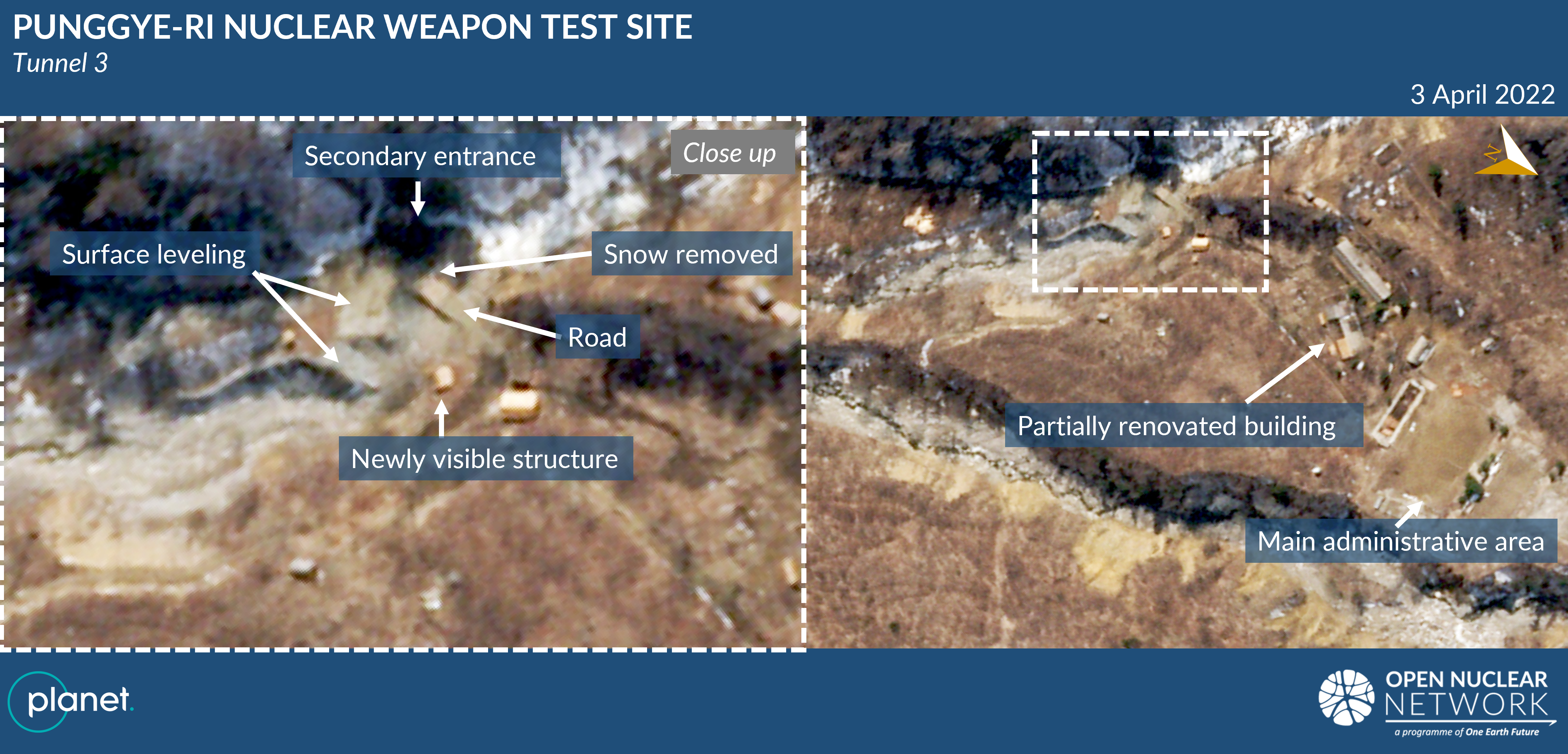
Image: © 2022 Planet Labs. All Rights Reserved. Reprinted by permission.
The spoils appear to have been added to the spoil pile, eventually, resulting in the expansion of the size of this spoil pile. Comparison of the satellite images from 31 March and 6 April 2022 show a growth in the spoil pile (Figure 5).
These signs suggest continuous progress in the excavation and restoration of Tunnel 3.
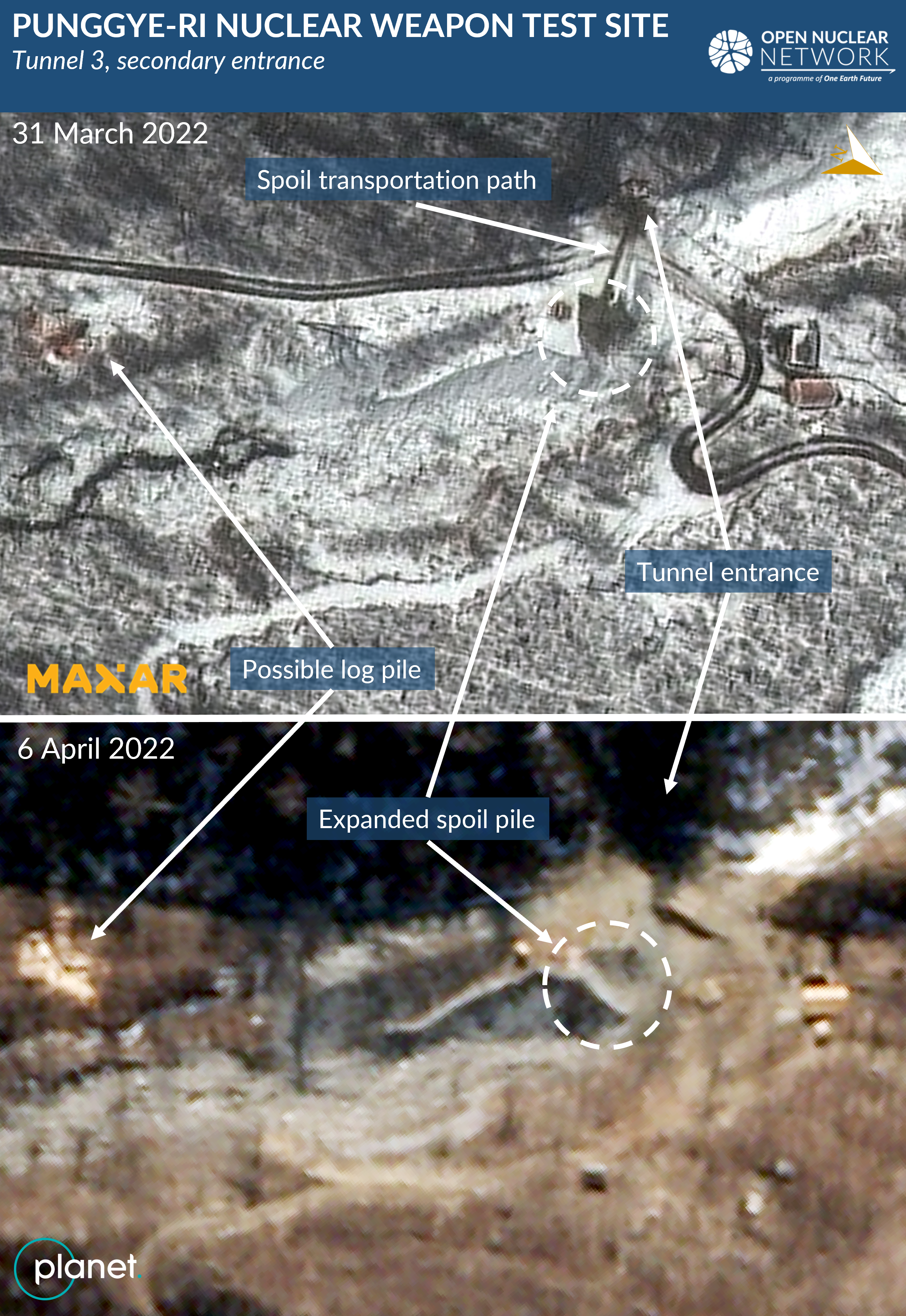
Image: © 2022 Maxar Technologies (top) and Planet Labs (bottom). All Rights Reserved. Reprinted by permission.
These observations further support ONN’s previous assessment that the DPRK is in the process of restoring Tunnel 3 of the Punggye-ri nuclear test site through its secondary entrance or a possible new entrance nearby.[5]
No signs of excavation or construction activities could be confirmed near the other tunnels in the Punggye-ri site.
Altogether, these observations continue to indicate that the DPRK has advanced work to restore a nuclear test tunnel for use in a potential next nuclear weapon test.
ONN will continue to monitor developments at the Punggye-ri nuclear test site.
[1] Katsuhisa Furukawa, Developments at the DPRK's Punggye-ri Nuclear Test Site since December 2021, Open Nuclear Network, 28 March 2022, available at: https://opennuclear.org/publication/developments-dprks-punggye-ri-nuclear-test-site-december-2021
[2] See, for example, 朝鮮の豊渓里核実験場を正式に廃棄 (7), People's Daily (Japanese edition), 25 May 2018, available at: http://j.people.com.cn/n3/2018/0525/c94638-9464267-7.html; 北朝鮮、核実験場の坑道3カ所を爆破 北部・豊渓里, CNN, 25 May 2018, available at: https://www.cnn.co.jp/world/35119787.html; and Tom Cheshire, Sky News witnesses "spectacular" explosions on North Korea "nuclear site", Sky News, 25 May 2018, available at: https://news.sky.com/story/sky-news-witnesses-spectacular-explosions-on-north-korea-nuclear-site-11383852
[3] Interview by email of Tom Cheshire, Sky News reporter, who observed the explosions at the Punggye-ri nuclear test site in May 2018. Video footage from the May 2018 explosion of Tunnel 3 was shared by Tom Cheshire, which shows that at least two explosions took place at or near Tunnel 3 - one which exploded the primary entrance to this tunnel, and the other which exploded the area adjacent to this primary entrance but not the secondary entrance. Also, see, Sky News witnesses "spectacular" explosions on North Korea "nuclear site", Sky News, 25 May 2018, available at: https://news.sky.com/story/sky-news-witnesses-spectacular-explosions-on-north-korea-nuclear-site-11383852
[4] 38 North also identified this tunnel entrance and this spoil pile. See, Jenny Town, Olli Heinonen, and Jack Liu, Punggye-ri Nuclear Test Site: Probable Spoil at the South Portal, 38 North, 31 March 2022, available at: https://www.38north.org/2022/03/punggye-ri-nuclear-test-site-probably-spoil-at-the-south-portal/
[5] Katsuhisa Furukawa, Developments at the DPRK's Punggye-ri Nuclear Test Site since December 2021, Open Nuclear Network, 28 March 2022, available at: https://opennuclear.org/publication/developments-dprks-punggye-ri-nuclear-test-site-december-2021